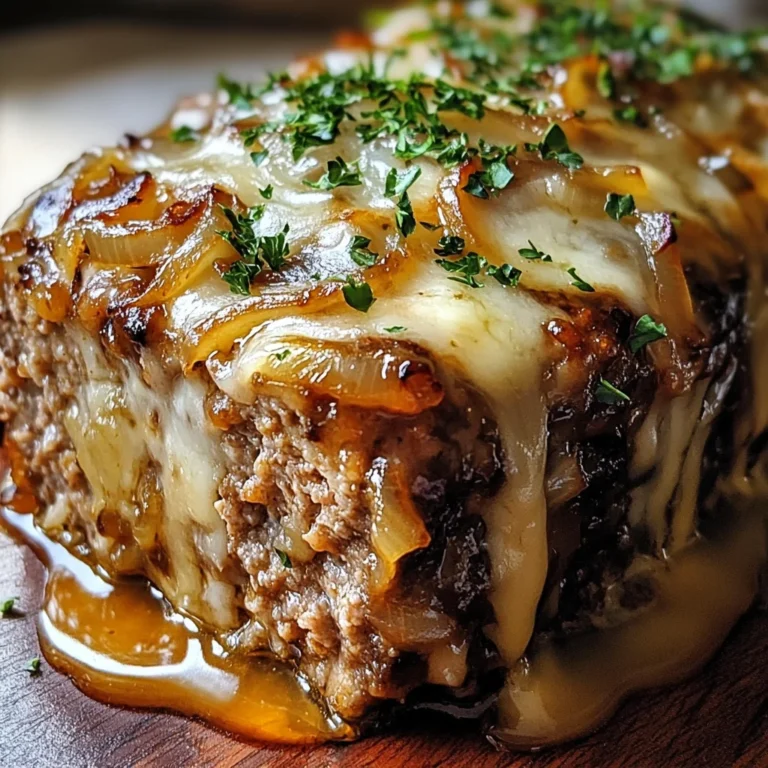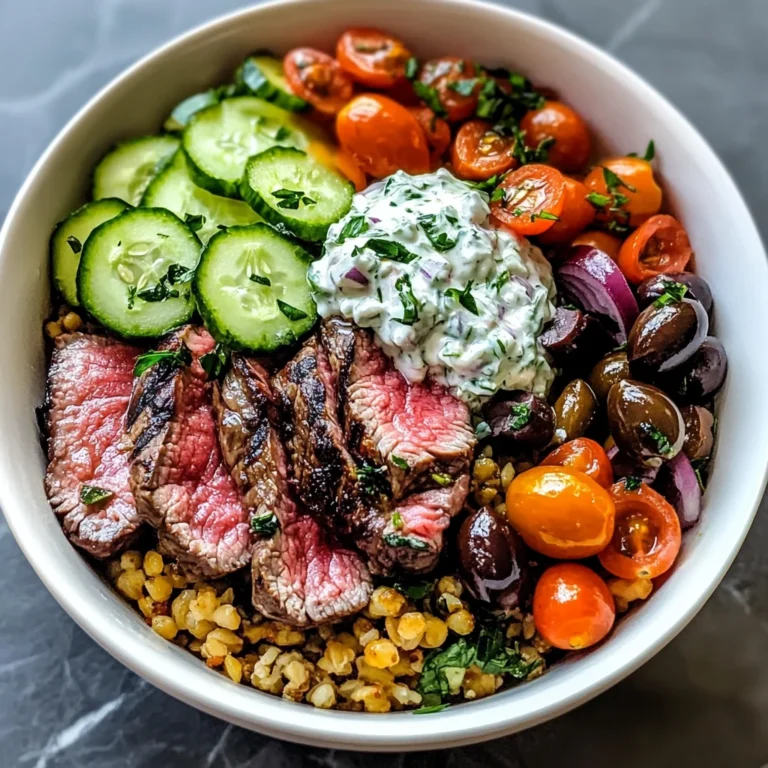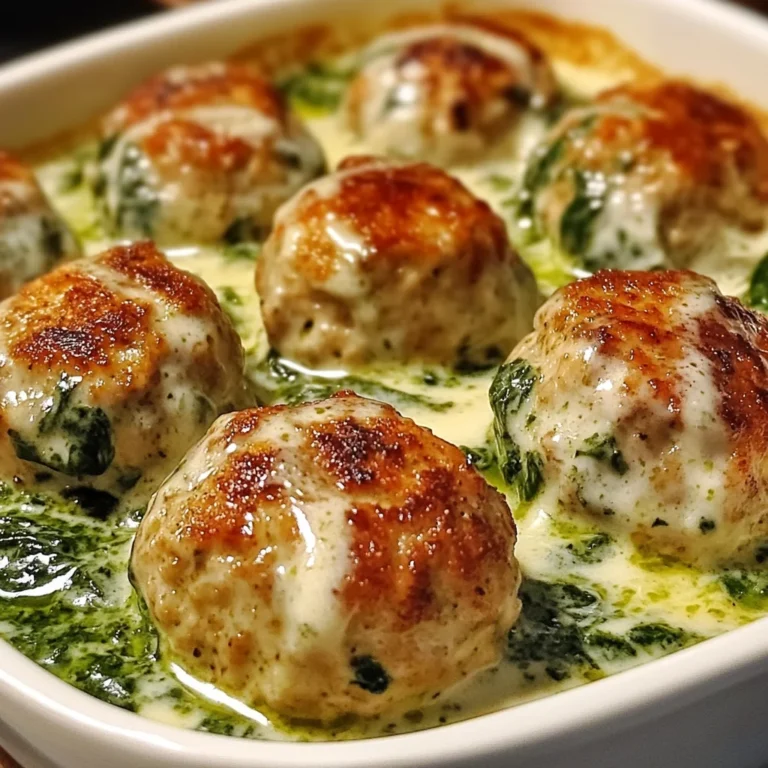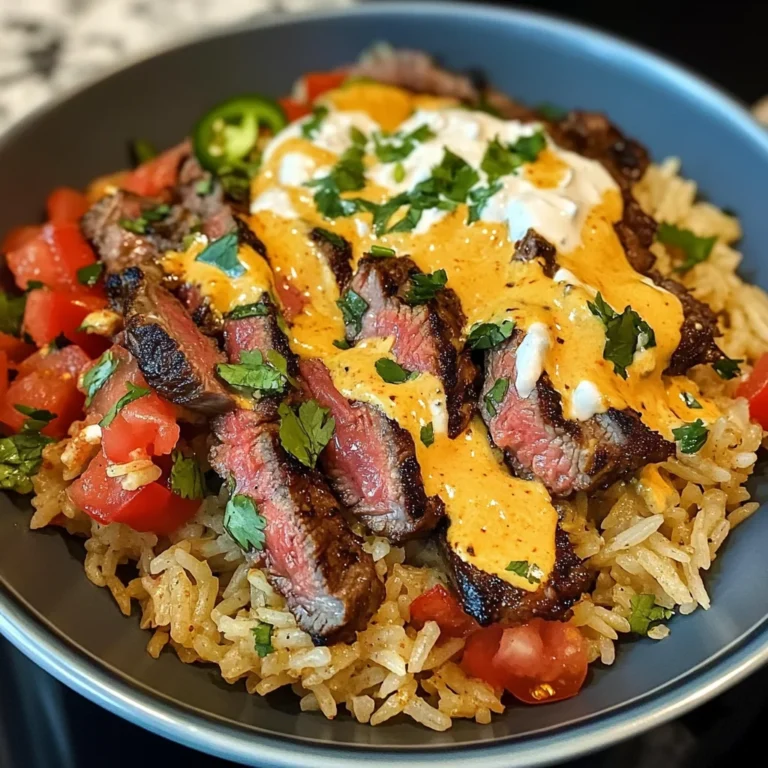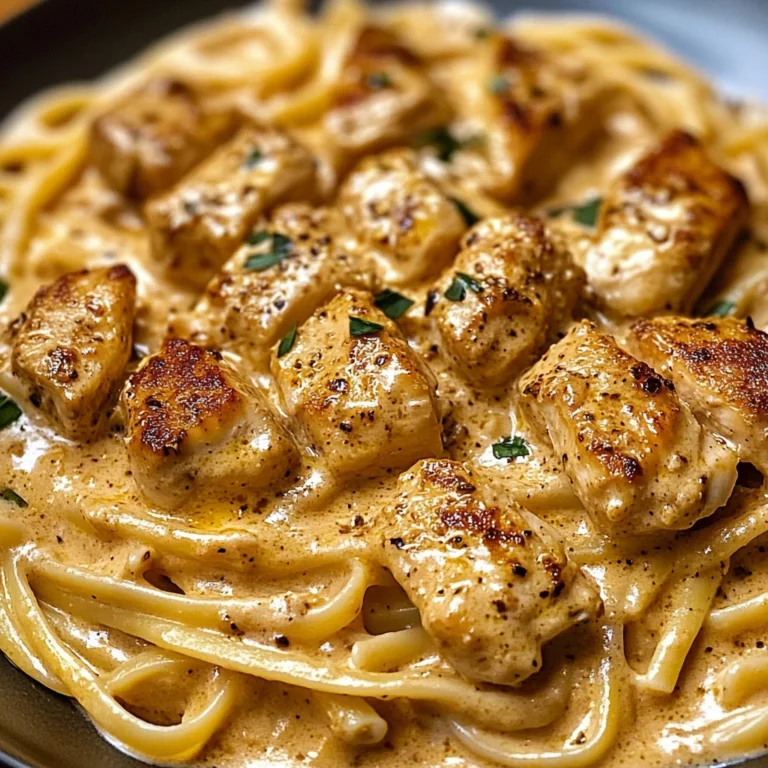Japchae
If you’re looking for a dish that brings warmth and joy to the table, Japchae is the perfect choice. This vibrant Korean recipe has a delightful blend of flavors and textures that makes it a favorite in my home. The chewy sweet potato noodles paired with fresh veggies and tender beef (or your choice of protein) create a meal that’s both satisfying and nutritious. Whether it’s a busy weeknight or a festive family gathering, Japchae is sure to impress everyone around the dinner table.
This dish not only tastes amazing but also allows you to customize it based on what you have in your fridge. You can easily swap out ingredients to suit your preferences, making it versatile for any occasion. Let me share with you why this recipe is so special to me!
Why You’ll Love This Recipe
- Quick and Easy: With just 30 minutes of prep time, Japchae is perfect for those nights when you want something delicious without spending hours in the kitchen.
- Family-Friendly: Everyone loves a good noodle dish! Kids will adore the chewy texture and colorful veggies, making it an easy way to get them excited about dinner.
- Make-Ahead Convenience: You can prepare Japchae ahead of time and reheat it for lunch or dinner throughout the week, saving you time while still enjoying a homemade meal.
- Endless Customization: Want to add some spice? Toss in some gochujang! Not in the mood for beef? Substitute with chicken or tofu. The options are endless!
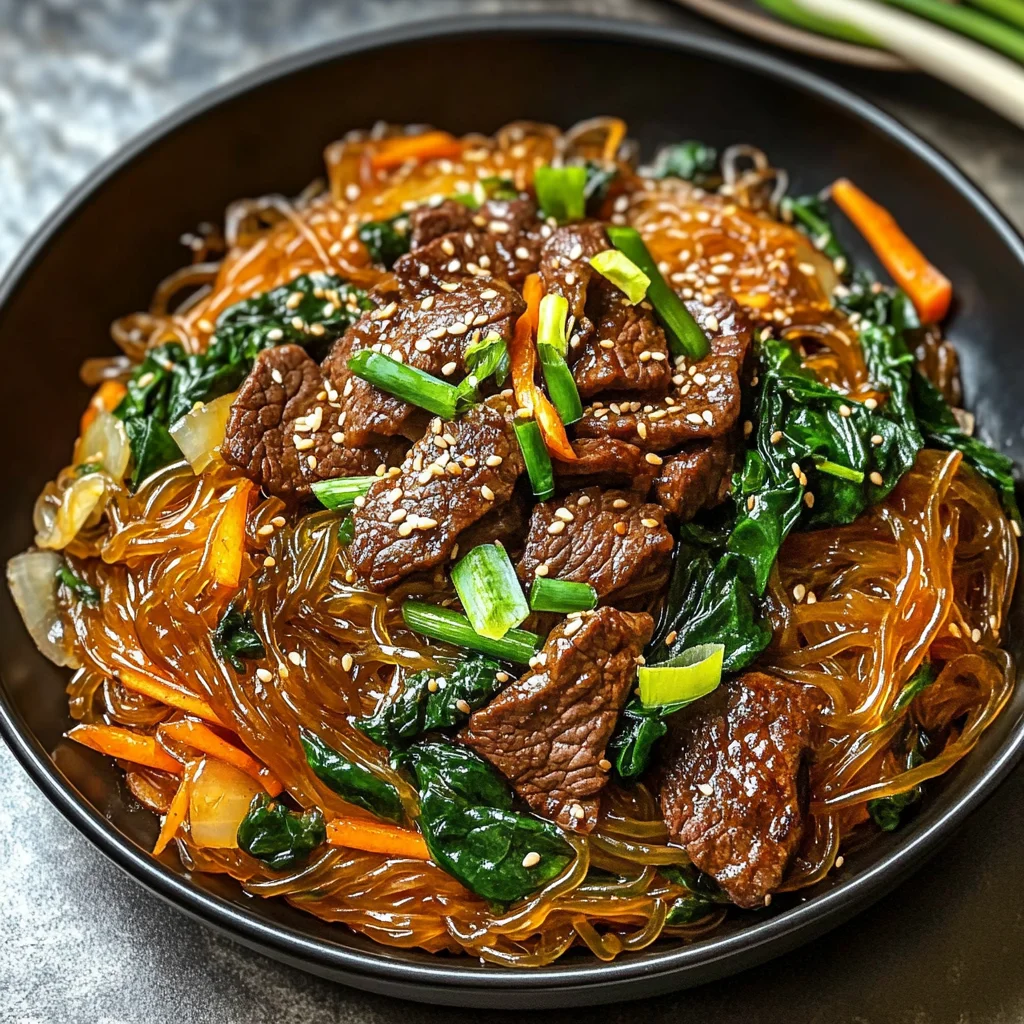
Ingredients You’ll Need
Gathering these simple, wholesome ingredients will ensure your Japchae turns out deliciously every time. They are easy to find at most grocery stores, so let’s see what you need!
For the Noodles
- 1 lb Korean sweet potato noodles (glass noodles)
For the Stir-Fry
- 2 lb thin-sliced beef (or sub with chicken, tofu, or shrimp)
- 3 medium carrots, julienned
- 1 large white onion, thinly sliced
- 1/2 lb spinach leaves
- 6 garlic cloves, minced
- 1/2 bunch green onions, chopped
For Seasoning
- 4 tbsp sesame oil (divided)
- 1 tbsp olive oil
- 6 tbsp soy sauce (or tamari for gluten-free)
- 3 tbsp brown sugar
Variations
Japchae is incredibly flexible! Feel free to play around with different ingredients based on your taste or dietary needs. Here are some fun variations:
- Swap the protein: Try using chicken, tofu, or shrimp instead of beef for a different flavor profile.
- Add some heat: If you enjoy spicy food, mix in a spoonful of gochujang for a kick!
- Bulk it up: Include more veggies like bell peppers or mushrooms for additional nutrition and color.
- Make it vegan: Simply replace the beef with tofu and use plant-based sauces to keep it completely vegan-friendly.
How to Make Japchae
Step 1: Cook the Noodles
Bring water to a boil in a large pot with a drizzle of olive oil. Add the sweet potato noodles and cook for about 5-6 minutes until they’re tender yet chewy. This step is crucial because perfectly cooked noodles will give your Japchae that signature texture we all love! Once done, drain them and set aside.
Step 2: Sauté the Beef
In a skillet over high heat, cook the thin-sliced beef until browned. As it cooks, season it with half of your soy sauce, sesame oil, and brown sugar. This not only adds flavor but also creates that lovely caramelization on the meat. Once browned, set aside.
Step 3: Stir-Fry the Vegetables
In another skillet, heat up some olive oil before adding your julienned carrots and sliced onion. Sauté them until softened—this step brings out their natural sweetness! After that, mix in the remaining soy sauce, sesame oil, brown sugar, garlic, and green onions; cook everything together for another minute.
Step 4: Add Spinach
Next up is adding those fresh spinach leaves! Stir them into the vegetable mixture until they wilt down nicely. This adds vibrant color and nutrients to your dish.
Step 5: Combine Everything
Now it’s time to bring it all together! In a large bowl or pot, combine all your cooked noodles along with the sautéed vegetables and beef. Toss everything well so each ingredient gets coated in those lovely savory flavors.
Serve Your Dish
Serve warm and garnish with extra green onions if desired. Each bite of this hearty Japchae will transport you straight to Korea—where comfort food meets culinary delight! Enjoy!
Pro Tips for Making Japchae
Creating the perfect bowl of Japchae is an art, but with a few helpful tips, you’ll be on your way to impressing your family and friends in no time!
-
Use fresh ingredients: Fresh vegetables not only enhance the dish’s flavor but also add vibrant colors that make your Japchae visually appealing. Look for crisp carrots, bright green spinach, and firm onions.
-
Don’t overcook the noodles: Sweet potato glass noodles are best when they retain a slight chewiness. Cooking them just until tender ensures they hold their shape and texture when stir-fried.
-
Customize your protein: Feel free to swap out beef for chicken, tofu, or shrimp based on your preference. Each protein adds its own unique flavor profile while keeping the dish versatile and enjoyable for everyone.
-
Adjust seasoning to taste: Everyone has different taste preferences! Start with the recommended amounts of soy sauce and brown sugar, then adjust as you stir-fry to find your perfect balance of savory and sweet.
-
Cook in batches if necessary: If you’re making a large quantity, consider cooking in batches. This prevents overcrowding in the pan, allowing each ingredient to cook evenly and develop its own flavor.
How to Serve Japchae
Presenting Japchae can be as delightful as making it! The colorful mix of ingredients is sure to catch the eye. Here are some serving suggestions to elevate your dining experience.
Garnishes
- Sesame seeds: Lightly toasted sesame seeds add a nutty flavor and a lovely crunch that complements the dish beautifully.
- Chili flakes: For those who enjoy a little heat, a sprinkle of chili flakes can provide an exciting kick without overpowering the sweet and savory notes.
- Fresh herbs: Adding freshly chopped cilantro or mint leaves enhances the freshness of the dish and offers a fragrant finish.
Side Dishes
- Kimchi: This classic Korean side dish adds a spicy, tangy contrast to the sweetness of Japchae. It’s not only delicious but also packed with probiotics!
- Korean pickled radish (Danmuji): These bright yellow pickles bring a crunchy texture and refreshing tartness that pairs perfectly with the rich flavors of Japchae.
- Steamed broccoli: Lightly steamed broccoli adds color and nutrition while offering a mild flavor that balances out the hearty noodles.
- Cucumber salad (Oi Muchim): A simple cucumber salad dressed with rice vinegar, sesame oil, and chili flakes provides a crisp bite that refreshes the palate between bites of flavorful Japchae.
With these tips and serving suggestions, you’ll create an unforgettable meal that brings smiles all around! Enjoy your culinary adventure with this delightful dish!
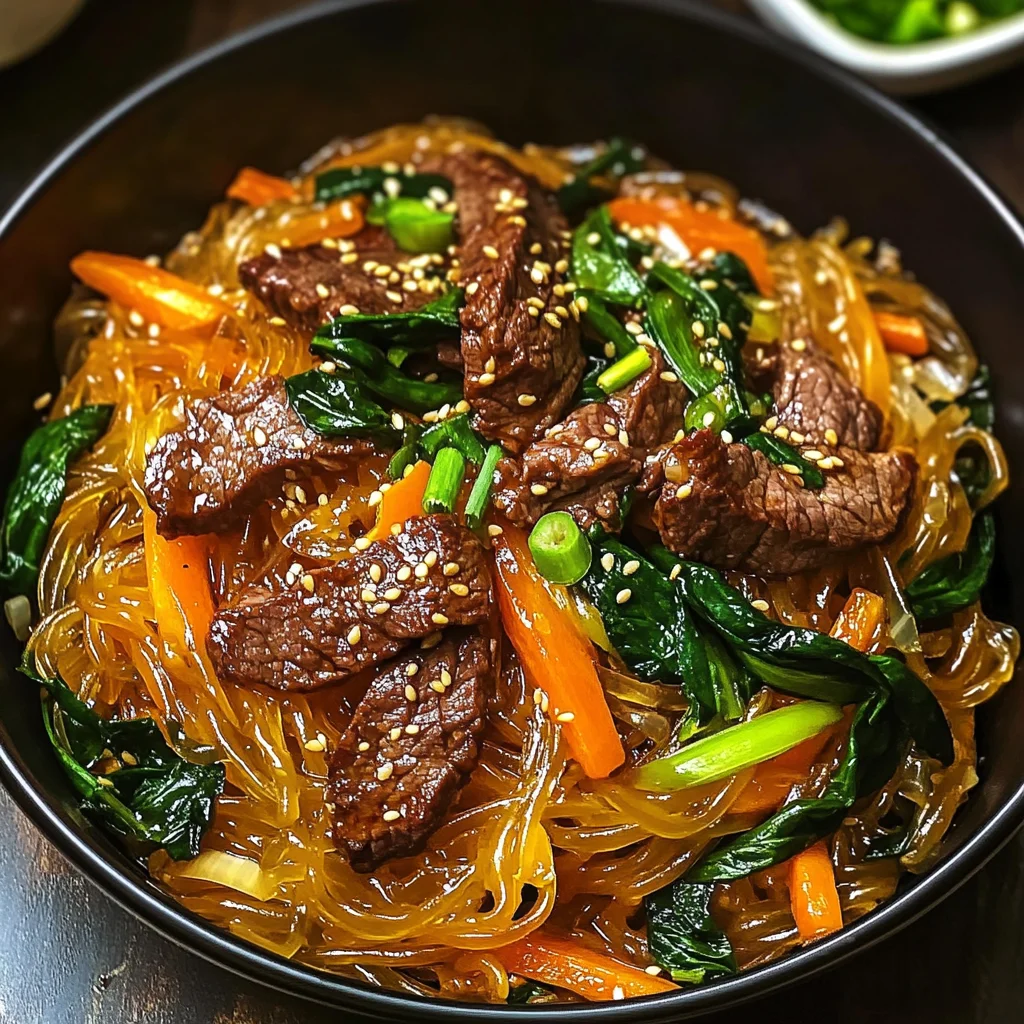
Make Ahead and Storage
Japchae is an excellent choice for meal prep, making it easy to enjoy delicious flavors throughout the week. You can prepare this dish in advance and have it ready for busy days or gatherings with family and friends.
Storing Leftovers
- Allow the Japchae to cool completely before storing.
- Transfer to an airtight container and refrigerate.
- Consume within 3-4 days for the best quality.
Freezing
- Let Japchae cool completely before freezing.
- Place in a freezer-safe container, leaving some space for expansion.
- It can be frozen for up to 2 months.
Reheating
- Thaw in the refrigerator overnight before reheating.
- Heat in a pan over medium heat, adding a splash of water or oil to prevent sticking.
- Stir until heated through, about 5-7 minutes.
FAQs
Here are some common questions you might have about making Japchae.
How can I make Japchae vegetarian?
You can easily make Japchae vegetarian by substituting the beef with tofu or other vegetables. Use soy sauce or tamari for flavor enhancement.
What are sweet potato glass noodles?
Sweet potato glass noodles are made from sweet potato starch, giving them a chewy texture. They are gluten-free and perfect for dishes like Japchae.
Can I add more vegetables to my Japchae?
Absolutely! Feel free to customize your Japchae by adding vegetables like bell peppers, mushrooms, or zucchini. This will add more color and nutrition!
How do I store leftovers of Japchae?
Store leftovers in an airtight container in the refrigerator for up to 3-4 days. For longer storage, freeze them for up to 2 months.
Final Thoughts
I hope you find joy in making this delightful Japchae recipe! It’s not just a meal; it’s a comforting blend of flavors that brings people together. Whether you’re enjoying it at home or sharing it with loved ones, each bite is sure to warm your heart. Enjoy every moment of your cooking journey!
Japchae
If you’re in search of a comforting and colorful meal, look no further than Japchae! This traditional Korean dish features chewy sweet potato noodles stir-fried with a variety of fresh vegetables and your choice of protein, making it a delightful option for any occasion. Whether it’s a busy weeknight or a festive gathering, Japchae is quick to prepare and offers endless customization possibilities. With its savory-sweet flavor profile and vibrant presentation, this dish not only satisfies hunger but also brings joy to the dining table.
- Prep Time: 15 minutes
- Cook Time: 15 minutes
- Total Time: 30 minutes
- Yield: Serves 6
- Category: Main
- Method: Stir-Frying
- Cuisine: Korean
Ingredients
- 1 lb Korean sweet potato noodles (glass noodles)
- 2 lb thin-sliced beef (or substitute with chicken or tofu)
- 3 medium carrots, julienned
- 1 large white onion, thinly sliced
- 1/2 lb spinach leaves
- 6 garlic cloves, minced
- 4 tbsp sesame oil (divided)
- 6 tbsp soy sauce (or tamari for gluten-free)
- 3 tbsp brown sugar
Instructions
- Boil water in a large pot and cook the sweet potato noodles for 5-6 minutes until tender yet chewy. Drain and set aside.
- In a skillet over high heat, sauté the thin-sliced beef until browned. Season with half of the soy sauce, sesame oil, and brown sugar. Set aside.
- In another skillet, heat olive oil and sauté julienned carrots and sliced onion until softened. Add remaining soy sauce, sesame oil, brown sugar, garlic, and green onions; cook for another minute.
- Stir in fresh spinach until wilted.
- Combine cooked noodles with sautéed vegetables and beef in a large bowl; toss to coat evenly.
Nutrition
- Serving Size: 1 serving
- Calories: 350
- Sugar: 5g
- Sodium: 800mg
- Fat: 12g
- Saturated Fat: 2g
- Unsaturated Fat: 8g
- Trans Fat: 0g
- Carbohydrates: 48g
- Fiber: 4g
- Protein: 15g
- Cholesterol: 30mg


